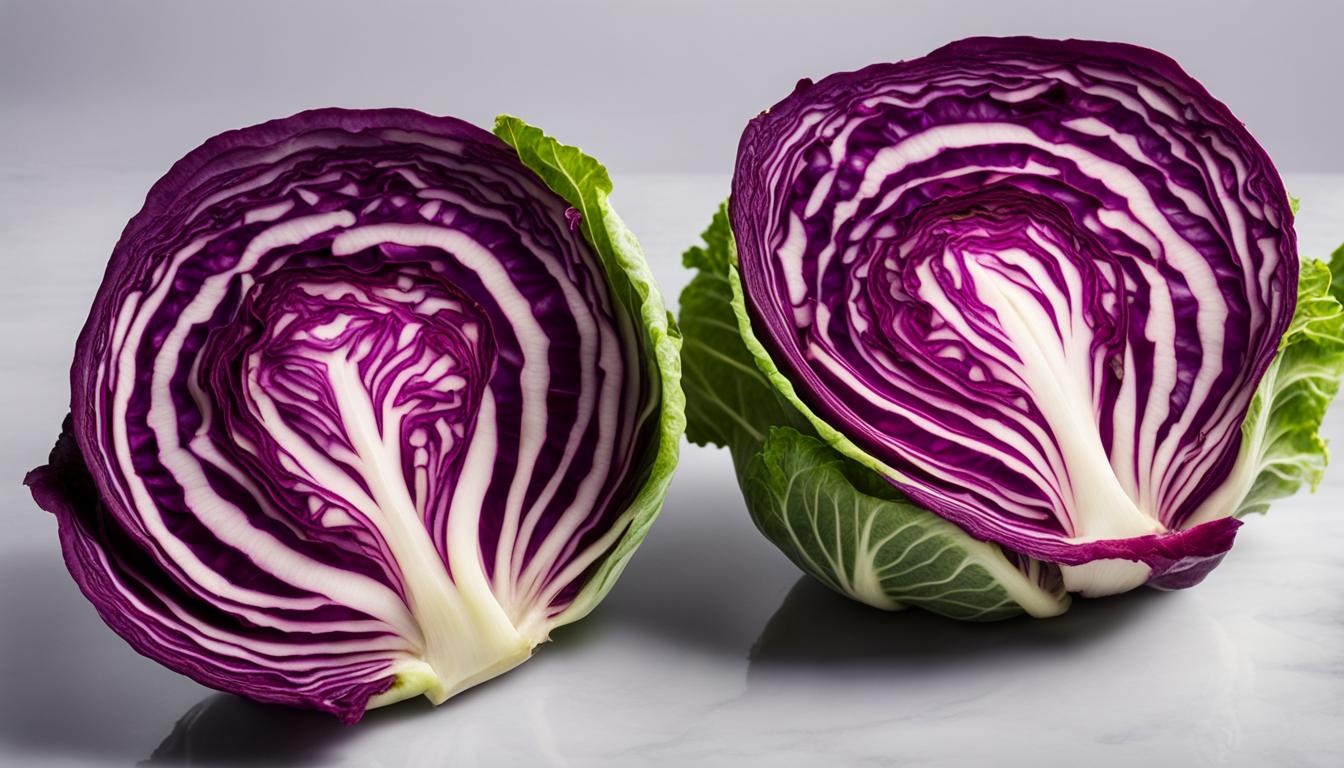Are you curious about the flavor difference between red cabbage and green cabbage? Do you wonder if they taste distinct from each other? Let’s explore the unique characteristics of these two cabbage varieties and uncover their individual tastes.
Key Takeaways:
- Red cabbage and green cabbage have distinct flavor differences.
- Red cabbage has a vibrant purple or red color and leaves that are thicker and crunchier.
- Green cabbage has a classic round shape with tightly packed pale green leaves that are thinner and more tender.
- Red cabbage offers a mildly peppery and earthy taste with a satisfying crunch.
- Green cabbage has a milder and slightly sweet flavor with a crisp texture that holds up well when cooked.
A Rich History and Cultivation of Red and Green Cabbage
Cabbage, in all its forms, has a rich and fascinating history that dates back thousands of years. Both red and green cabbage varieties have played significant roles in the culinary traditions of different cultures around the world.
The origins of cabbage can be traced back to ancient civilizations in the Mediterranean region. The cultivation of red and green cabbage spread across Europe during the Middle Ages, where they became staple ingredients in traditional dishes. Over time, cabbage varieties were introduced to different parts of the world, including Asia and the Americas, where they continue to be enjoyed today.
Red and green cabbage are cool-season vegetables that thrive in temperate climates. They are typically grown as annual crops and require specific soil conditions, sun exposure, and adequate moisture for optimal growth. Farmers carefully cultivate these varieties to ensure they develop the desired color, texture, and taste.
The Origins of Cabbage
The exact origins of cabbage are uncertain, but it is believed to have descended from wild cabbage plants found in the Mediterranean region. Ancient civilizations, such as the Greeks and Romans, valued cabbage for its medicinal and culinary properties. The cultivation and consumption of cabbage spread throughout Europe, gradually evolving into the distinct red and green cabbage varieties we know today.
Commercial production of red and green cabbage takes place in various countries worldwide. China, India, Russia, and the United States are among the top producers of these nutritious vegetables. Their widespread cultivation ensures a steady supply of both red and green cabbage varieties throughout the year.
| Red Cabbage | Green Cabbage | |
|---|---|---|
| Scientific Name | Brassica oleracea var. rubra | Brassica oleracea var. capitata |
| Color | Vibrant purple or red | Pale green |
| Taste | Mildly peppery and earthy | Mild and slightly sweet |
| Texture | Thicker and crunchier leaves | Thinner and more tender leaves |
| Cultivation | Cool-season vegetable | Cool-season vegetable |
| Origin | Mediterranean region | Mediterranean region |

Understanding the history and cultivation of red and green cabbage helps us appreciate their cultural significance and the efforts involved in producing these nutritious vegetables. In the next section, we will explore the visual and sensory experience these cabbage varieties offer.
A Visual and Sensory Experience: Red Cabbage vs Green Cabbage
When it comes to the visual appeal of cabbage, red cabbage and green cabbage offer distinct experiences. Red cabbage stands out with its vibrant purple or red color that adds a pop of brightness to any dish. On the other hand, green cabbage maintains a classic appearance with pale green leaves that retain their color even after cooking.
But it’s not just the appearance that sets these two cabbage varieties apart. They also differ in taste and texture. Red cabbage has sturdy yet tender leaves that provide a satisfying crunch. Its flavor is mildly peppery and earthy, adding a hint of robustness to dishes. Green cabbage, on the other hand, boasts a mild and slightly sweet flavor with a crisp texture that holds up well when cooked.
While each variety has its own unique qualities, red cabbage can be used as a substitute for green cabbage in most recipes. With their similar flavors and forms, red and green cabbage can both contribute to delicious culinary creations.

Table: A Comparison of Red Cabbage and Green Cabbage
| Aspect | Red Cabbage | Green Cabbage |
|---|---|---|
| Appearance | Vibrant purple or red color | Pale green color |
| Taste | Mildly peppery and earthy | Mild and slightly sweet |
| Texture | Sturdy yet tender, offering a satisfying crunch | Crisp and holds up well when cooked |
Table: A Comparison of Red Cabbage and Green Cabbage
As shown in the table above, red cabbage and green cabbage differ in appearance, taste, and texture. These distinctive qualities make them suitable for different culinary applications, allowing you to experiment with flavors and create visually appealing dishes. Whether you choose red cabbage or green cabbage, both varieties offer a visual and sensory experience that can elevate your meals.
The Nutritional Powerhouses: Red Cabbage and Green Cabbage
When it comes to nutrition, both red cabbage and green cabbage are impressive powerhouses. These cruciferous vegetables are packed with essential vitamins, minerals, and antioxidants that contribute to overall health and well-being.
Red cabbage, with its vibrant purple or red color, contains high levels of vitamin C, which plays a crucial role in supporting the immune system and promoting collagen production for healthy skin. It is also rich in cancer-fighting flavonoids and antioxidants that help protect cells from damage caused by free radicals.
On the other hand, green cabbage is equally nutritious, offering a range of health benefits. It is particularly high in antioxidants, such as beta-carotene, which the body converts into vitamin A. This vitamin is vital for maintaining good vision, supporting immune function, and promoting healthy skin. Green cabbage is also a good source of dietary fiber, which aids in digestion and helps keep you feeling full.
Comparing the Nutritional Content of Red and Green Cabbage
| Nutrient | Red Cabbage (1 cup, chopped) | Green Cabbage (1 cup, shredded) |
|---|---|---|
| Calories | 28 | 22 |
| Carbohydrates (g) | 6.6 | 5.2 |
| Fiber (g) | 2.2 | 2.2 |
| Vitamin C (mg) | 56.6 | 37.8 |
| Vitamin A (IU) | 34 | 68 |
| Calcium (mg) | 71 | 40 |
| Potassium (mg) | 218 | 216 |
While red cabbage and green cabbage have slightly different nutrient profiles, both contribute to a well-rounded and nutritious diet. Incorporating these colorful vegetables into your meals can provide a range of health benefits and help support your overall well-being.

Comparing Red Cabbage and Green Cabbage
When it comes to red cabbage and green cabbage, there are both similarities and differences to consider. As members of the same botanical family and as cruciferous vegetables, they share many health benefits and have similar macronutrient profiles. Both red and green cabbage are low in calories and high in dietary fiber, making them excellent choices for a balanced diet.
However, there are noticeable differences between the two varieties. Red cabbage stands out with its vibrant color, ranging from deep purple to bright red. It adds a visually striking element to any dish. Its leaves are sturdier and crunchier compared to the thinner and more tender leaves of green cabbage.
In terms of taste, red cabbage offers a mildly peppery and earthy flavor, while green cabbage has a mild and slightly sweet taste. When it comes to texture, red cabbage’s crunchiness provides a satisfying bite, whereas green cabbage maintains a crisp texture even after cooking.
Ultimately, the choice between red cabbage and green cabbage depends on personal preferences and the desired visual and sensory experience in your culinary creations. Whether you opt for the vibrant color and crunch of red cabbage or the classic appearance and mild taste of green cabbage, both varieties offer unique qualities that can elevate your meals.
Source:
https://en.wikipedia.org/wiki/Red_cabbage
Zaki Infitar is the driving force and creative mind behind GreenBuilt.co. As a self-taught gardener with an unwavering passion for all things green, Zaki’s journey into the world of gardening is a testament to his dedication and love for nature.

